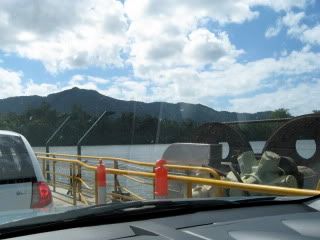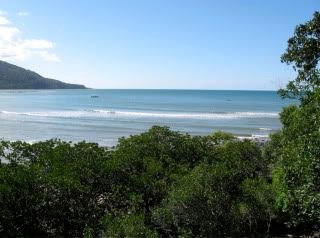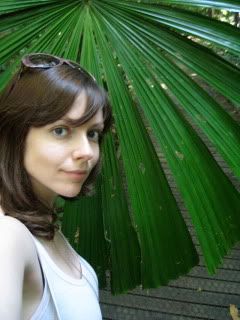FINALLY here is the lowdown on our final day up in the tropics. And it was a good'un. We wanted to head up into the Daintree National Park, as far as Cape Tribulation, so named by Captain Cook in 1770 after his ship ran aground on the reef just off the coast. It now is also referred to as 'Kulki', the original aboriginal name for the site. People are now shifting back towards using the aboriginal names for certain parts of Australia (such as 'Uluru' instead of Ayer's Rock) as they have realised that renaming sacred sites in reference to Australia's European colonialists was actually quite offensive.
We made a moderately (by Fellows standards) early start and headed north out of Port Douglas to the Daintree River, which marks the entrance to the National Park. There is no bridge across the river: instead, they have preserved the original way of entering the rainforest, which involves the Daintree River Ferry. This is basically a flat topped boat which you drive your car onto, and then drive off when the boat reaches the other side! Quite an experience! There is also a little section for pedestrians to stand in.

It holds quite a number of cars at once, so we didn't have to wait too long to board. Once over the other side, we were off into the rainforest!
The road is narrow and windy within the National Park, and since we were stuck near the back of all the cars that had been on our ferry-load, it was a bit slow going as people drove carefully. So, we decided to stop off for a bit and do the Jindalba boardwalk.
There are a handful of these boardwalks in the Daintree. They basically build a raised wooden path along a short route, which allows you to enter the forest and have a look. Of course, it would be near impossible otherwise to go for a walk as the forest is too thick and the ground to uneven, in some areas too swampy, and of course the undergrowth may harbour all manor of deadly wildlifes.

Bec on the boardwalk.
It is surprisingly cool under the canopy, and it's a quiet, peaceful place. Although we were on constant guard for any wandering Cassowaries that might appear! The Cassowary is a huge, flightless bird - as big as a man - that inhabits this area. It is critically endangered, only an estimated 1500-3000 currently exist in north Queensland, but they all live in a very small area in the wet tropics and are actually sighted on a reasonably regular basis. This does make them sound rather fascinating, but the trouble is, they are incredibly aggressive and have razor sharp spurs on their legs. They run at you to attack, and are capable of disemboweling you, probably before you've even realised what you are looking at. The Guiness World Records book lists the Cassowary as the world's most dangerous bird. So we didn't really want to meet one of them. There are numerous advice signs around the boardwalk areas advising you that if you see one, to try to put something in between you and it, like a tree.
After the boardwalk, we continued on up the road, which was now clearer of traffic. After stopping at a cafe for lunch, we arrived at Cape Tribulation in the mid-afternoon.

[Perephoto]
Cape Tribulation has such an amazing feel, it is like nowhere else I have ever been. The light is strong and very harsh, which meant my photos didn't come out that well. It is a beautiful, golden sandy beach but is eerily quiet and relatively person-bare. There were a few people walking up and down, but none of the usual beach activity, like swimming and sunbathing. The main reason for the lack of swimming is clear from the prominent warning signs all along the beach - you are deep into crocodile territory. Crocodile attacks can kill you in an instant, and the croc population is thriving in the rivers and creeks that open into the sea around Cape Tribulation due to the area's relatively untouched state. My Rough Guide says that you may even see them sunbathing on the beach at Cape Trib.!



Cape Tribulation feels like the End of the World might feel. A calm, peaceful place with an undercurrent of vague unease. It is also literally the End of the World for many visitors to the north Queensland tropics. The sealed road to the north ends just after the turn off to the small car park, and continues as a mere dirt track up to Cooktown and the nothingness of the northernmost tip. Impassable to all but experienced 4WD drivers most of the time, and for parts of the wet summer season completely impassable to all due to flooding, many travellers simply make Cape Tribulation the end of the road.

Cape Tribulation is also one of the only places in the world where two World Heritage Sites meet - the Wet Tropics and the Great Barrier Reef. From the lookout point up on the Cape, you get a good view out over the Coral Sea.

We had a stroll up and down the sand and up to the lookout point. Mangroves line the edges of the sand, feeding from the salt water. Beyond is dense rainforest.
After a good bit of exploring and crocodile aversion, we drove a short distance back down the road to the Dubuji boardwalk, a longer boardwalk that takes in mangrove swamps.


These leaves were HUGE!

Swampy. There were a lot of shapes moving in the water. I don't imagine that stagnant brown water is a particularly healthy environment in which to live, but apparently in the wet season there is a lot more water so the creatures must just cling on to life until it gets good again.

Mangroves!
On the way back to Port Douglas, we stopped off at another couple of beaches on the Daintree coast - Myall beach just the southern side of the Cape, and Cow Bay further south.

Stinger warning. Fortunately, dry season is stinger safe as they are all vacationing in other waters. There seems to have been a lot of worry about dangerous animals in this blog post so I'll round it out with some info about marine stingers - or to give them their correct title, Box Jellyfish.
Box Jellies are, quite simply and quite officially, the deadliest living thing on earth. They contain enough venom to instantly kill 60 adult humans, and there have been over 5500 recorded deaths since 1954. Even if you survive the sting, you may suffer a heart attack and drown before you can get back to shore. Their tentacles can be up to 3 meters long and in the water they are so transparent that they are practically invisible. The pain of the sting is agonizing, and tales are told of victims continuing to scream even after being knocked out with morphine. Best avoided.
---
So that is almost all for Queensland. The following day was the day of our return to cold cold Sydney. But before the flight we just had time to go check out the marina side of Port Douglas, and the resort of Palm Cove north of Cairns. Pictures to follow in another entry!
As usual, additional bonus photos!! can be found at Flickr.


No comments:
Post a Comment